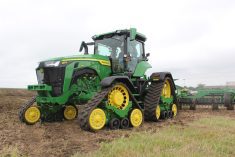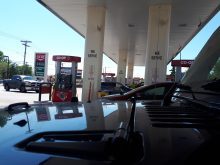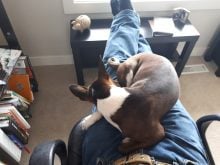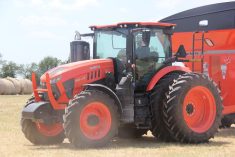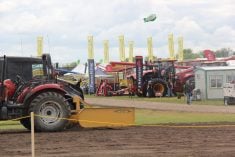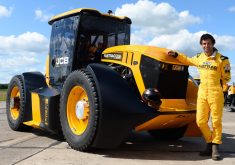One of the great things about being a
machinery editor is you occasionally get invited to vist engineering and assembly
plants. R&D facilities, where machines are designed and tested, are fascinating. Watching new
tractors go through a variety of tests intended to break them is
something to see.
The testing bays at R&D
facilities belonging to the major manufacturers involve some pretty sophisticated technology, almost all
of which is computer controlled. For example at the ride-simulation
Read Also
Movin’ On
Me, a little dusty after a long day of equipment field testing in Texas Aside from…
hydraulically-controlled platforms. Each one independently bounces
the tractor around according to data fed into a program. It can
simulate a back-breaking, high-speed run over very rough ground or
other experience based on real-world situations. After several hours
of this punishment, engineers check axles and chassis components for
cracks.
And while you really have to pity the
tractor chosen for this test, the automated procedure means some poor
engineering technician doesn’t have to drive it over a bump track for
hours on end to get the same result, which
was standard operating procedure a couple of decades ago.
Even though there is still a need for
physical testing, engineers now can be pretty certain components will pass before things get to that stage. Once again, using
computers allows them to reliably predict a system’s durability.
But long before a tractor ends up
taking real punishment in a testing bay, engineers turn to the
virtual world early on in the development process. They use 3-D computer simulation to fine tune a machine’s design.

John Deere’s virtual reality booth
at their Waterloo, Iowa, facility allows engineers to stand inside a
3-D image and evaluate everything from component design to HVAC
air-flow patterns in the cab. Photo: courtesy John Deere.
I’ve been lucky enough to get a
firsthand look and feel of that virtual world a couple of times. At
Case IH’s Burr Ridge, Illinois, R&D facility, engineers used
state-of-the-art virtual modelling to design the new Magnum and
Steiger tractors, which were introduced in August. And they gave
journalists a chance to experience how it was done during a media
event last summer.

When photographed in Case IH’s
virtual reality room, the image of this Steiger looks a little blurry. But sitting in front of the screen with the correct glasses, it looks so convincing you’re tempted to duck to avoid being hit by it as
the computer operator rotates the image.
Getting a chance to sit inside a
virtual Steiger was an opportunity I couldn’t pass up. To do it, I
sat in a tractor seat that was positioned in front of a wall-sized
screen and put on the 3-D headset along with a special glove fitted
with computer sensors. As a technician started the program, I
suddenly found myself inside the cab of a virtual tractor, with the
ability to reach out and touch the controls. As I turned my head, I
could look out all the windows and get a feel for the space and
control arrangements inside. It was an entertaining experience, but
According to Case IH staff, this
technology is priceless. It’s a chance to do things like get a feel
for proposed control layouts and vision obstructions before investing
time and energy building a component. And as individual engineers
work on sperate projects, all of which are intended to come together
on one machine, Case IH’s program is capable of marrying all the
separate computer designs together. The team can then actually see
how each part looks on the tractor. That ensures a seamless fit into
the overall design, ensuring there are no conflicts with other
sub-assemblies. All of this happens before anyone cuts a single piece
of steel.
In the past, technicians would have to
hand-fabricate parts and physically bolt them together to build a
design prototype. Often, parts wouldn’t mate properly or they’d need
refinement, and the process would have to be repeated until
everything fit as it should. That took time and cost a lot of money.
Now, not until everything checks out in the animation program do
technicians actually build it.
The result is machines make the
transition from concept to farm field in record time with minimum
development costs. The good news is if manufacturers can turn out a
machine more economically, farmers may not have dig as deeply into
their pockets to buy it.
Scott




